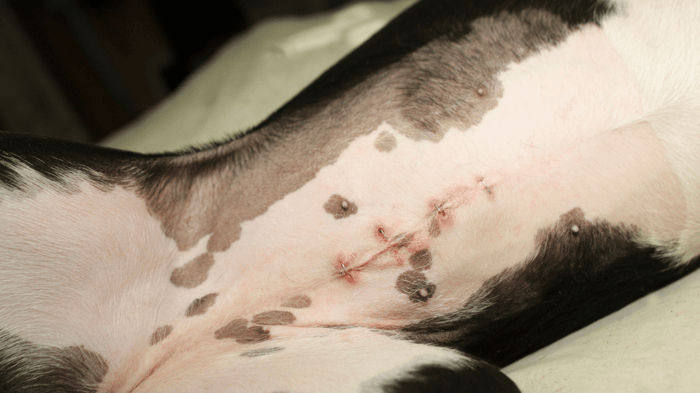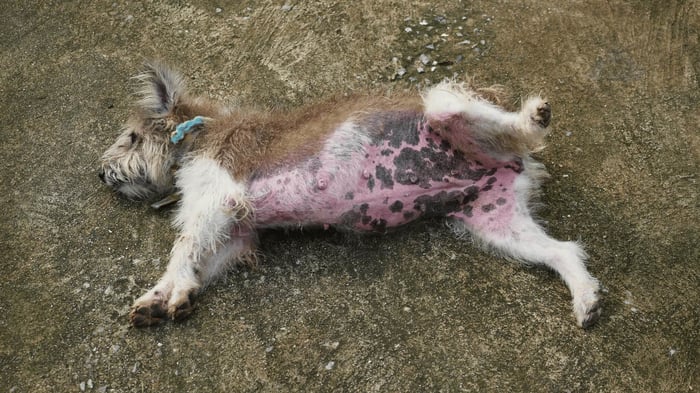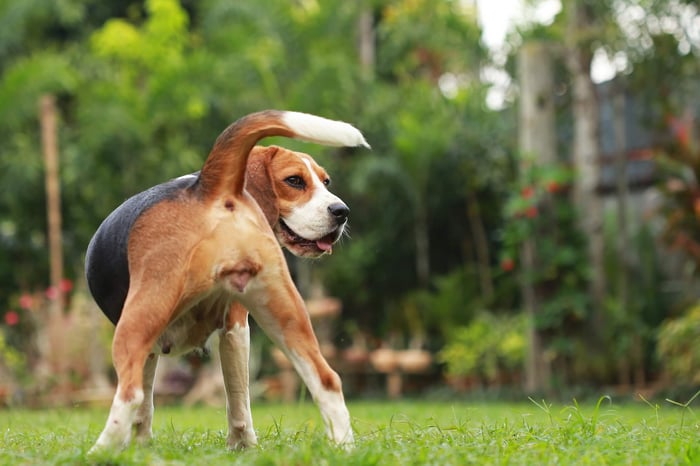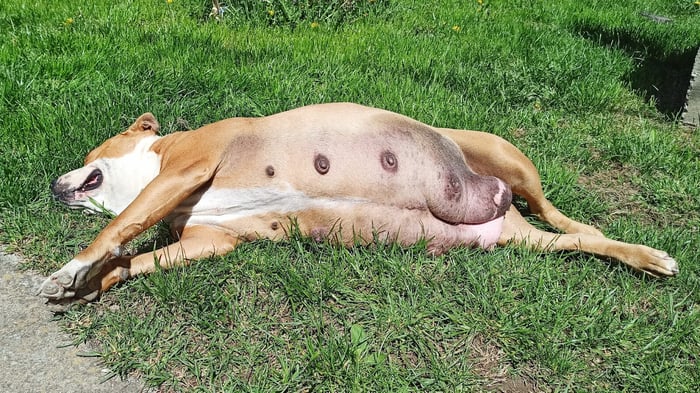Dog owners who have recently had their pets spayed may be concerned when they notice that the incision site has broken open. This is a traumatizing experience, but it pays to know that it is not uncommon.
Dogs are naturally active animals, and keeping them still and calm can be challenging after surgery. Typically, after a successful spay, a female dog will be up and running just 24 hours after surgery. And, too much activity can strain the incision site, causing it to open up. It is crucial to seek veterinary attention as soon as possible if a dog’s incision has broken open, as this can lead to further complications if left untreated.
In this article, we will help you understand the causes of a broken dog spay incision, the potential complications that can arise, and how to handle the issue. We will also provide tips on caring for a dog after spaying surgery to minimize the risk of complications and ensure a smooth recovery.
So, What Should You Do If A Dog’s Spay Incision Broke Open?
If a dog’s spay incision breaks open, it may indicate an infection on the incision site, probably due to licking. It is essential to take immediate action to prevent further complications. Actions to take include, contacting a vet, keeping the area clean and dry, monitoring the incision, limiting your dog’s activity, and administering medication.
Also, see this article if your dog’s stitches open, but there is no bleeding.
1. Contact a Veterinarian
The first step is to contact a veterinarian immediately. They will assess the situation and guide what to do next. They may recommend cleaning the area and applying an antibiotic ointment if the incision is minor. However, they may recommend surgery to repair the wound if the incision is severe.
2. Keep the Area Clean
It is crucial to keep the area clean to prevent infection. Use a clean cloth to clean the area around the incision gently. Avoid using harsh chemicals or soaps, as they may irritate the wound. Read this article for advice on what to put on a dog’s wound.
3. Keep the Area Dry
After cleaning, ensure the incision area remains dry. Excess moisture can lead to infection.
4. Monitor the Dog
Keep a close eye on the dog to ensure they do not bother the wound. Use an Elizabethan collar to prevent the dog from accessing the area if necessary.
5. Administer Medication
The veterinarian may prescribe antibiotics or pain medication, such as Non-steroidal Anti-inflammatory drugs, to help the dog heal and handle the pain. Follow the instructions carefully and complete the entire course of drugs to ensure the dog recovers fully.
6. Prevent the Dog from Licking
Your pup will want to lick the area to tolerate the discomfort. Licking the wound tends to cause irritation, inflammation and infection, as well as swelling, which is the major reason the stitches may break open after spay surgery.
7. Apply Pressure
You can apply gentle pressure with a clean gauze pad to stop the bleeding. Be cautious not to press too hard, as it may cause further damage.
8. Limit the Activity
Reduce your dog’s physical activity to a minimum. Rest is important for proper wound healing. Take your dog out on a leash only to poop for the first two weeks. Do not allow them to move around unmonitored. They may start playing, leading to the reopening of the incision.
Follow the vet’s instructions carefully and keep the area clean to prevent infection. With proper care, the dog should recover fully.
Causes of Dog Spay Incision Broke Open
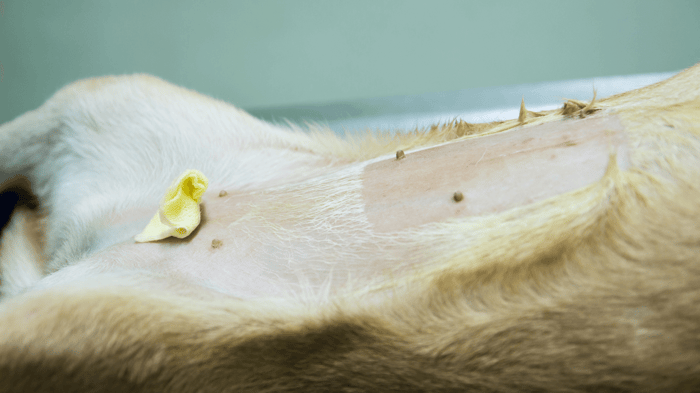
Dog Spay Incision Broke Open, or incisional dehiscence, is when a wound separates after surgery. This can result in the wound getting infected, causing more damage if untreated promptly. Dogs going through this may show signs of lethargy, lack of appetite, and excessive thirst.
There are several reasons why a dog spay incision may break open, and it is essential to understand the potential causes and how to treat the issue. Incision dehiscence may be caused by:
1. Licking or Chewing
Experts report that dog licking their wounds moderately could help to heal as their saliva contains antimicrobial properties that hinder bacteria growth. However, when a female dog licks her spay incision, it often becomes infected and inflamed and starts to ooze. The swelling then causes the stitches to rip open. So making sure your dog can’t lick the incision or stitches is vital to making sure the wound does not break open.
2. Excessive activity
Dogs love to be all over the place. If your dog engages in too much physical activity, like jumping and running around, it can stress the incision area, causing it to open. You can achieve this by having them on a leash during the potty breaks and putting them in their crate.
3. Obesity
Dogs that are overweight or obese may have excess fat in the abdominal area, which can strain the incision site and increase the risk of it breaking open.
4. Infections
Infections at the incision site can weaken the tissues, making them more likely to break open. The area can cause inflammation and interfere with proper wound healing if the area becomes infected.
5. Medical Conditions
According to experts, certain medical conditions, such as diabetes or immune system disorders, can affect the body’s ability to heal correctly, potentially leading to complications with the incision.
Understanding Dog Spay Surgery
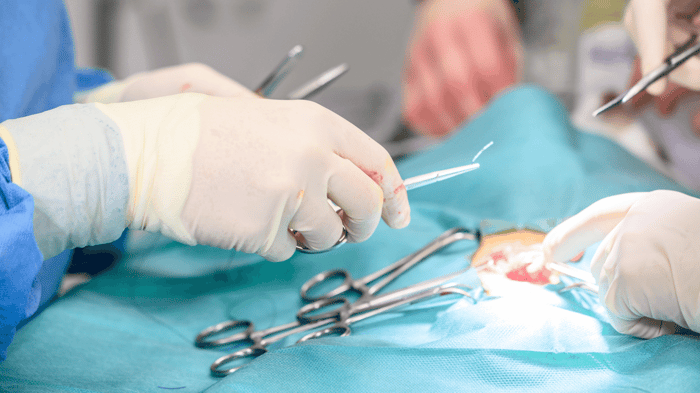
Studies show that spying on a female dog can boost their immune system and reduce the risk of breast cancer. Dog owners will also not have to worry about what to expect from a female dog after mating and why their dogs’ nipples enlarge after heat because their spayed pup will not even get into heat.
By understanding the potential risks and how to manage them, dog owners can help their pets recover from spaying surgery successfully and avoid unnecessary stress and worry. Dog spay surgery is common for female dogs to remove their reproductive organs. The surgery is also known as ovariohysterectomy and is done under general anesthesia.
The incision site is usually closed with sutures or staples and covered with a bandage. The dog is then monitored closely during recovery to ensure that the incision site heals appropriately and there are no complications.
It is important to note that dog spay surgery is significant and should only be performed by a licensed veterinarian. The surgery carries some risks, including bleeding, infection, and adverse reactions to anesthesia.
Owners should also be aware of the warning signs after spaying their dogs to make the whole recovery period easy and comfortable for their dogs. It is essential to follow all post-operative instructions from the veterinarian to ensure a smooth recovery. This may include limiting the dog’s activity, providing pain medication, and monitoring the incision site for signs of infection.
Recognizing a Broken Open Incision After Spay Surgery
After a dog undergoes spay surgery, monitoring the incision site for any signs of complications is essential. Recognizing the symptoms of a broken open incision is crucial to ensure proper treatment and prevent further complications.
Here are some signs to look out for to recognize a broken open incision after spay surgery:
- Bleeding: If the incision site is bleeding, it is a clear sign that the incision has broken open. If the bleeding is severe, it may require immediate medical attention. However, when the incision has broken loose but not bleeding, it may mean it has already formed a scab, which may act as a barrier to stop bleeding.
- Redness and Swelling: A broken open incision may appear red and swollen, indicating an infection or inflammation. You may also notice blood blisters on the area around the incision.
- Discharge: Experts suggest that a small amount of pus may come from the incision, but it is considered normal. It should be a case of concern when there is swelling and warmth around the wound.
- Visible Tissues: If you can see any underlying tissues or organs, the incision has broken open and requires immediate medical attention.
If you notice any signs of a broken open incision, it is essential to contact a veterinarian immediately. The veterinarian may recommend antibiotics, pain medication, or additional surgery to repair the incision site. Early detection and treatment are critical to ensure your dog’s smooth and successful recovery.
Visiting the Vet: What to Expect
When you arrive at a veterinary office with your pet, you can expect a series of standard procedures and interactions. A veterinary technician or assistant will examine the dog. They will take the dog’s vital signs, including their temperature, heart rate, and respiratory rate. The vet will then physically examine the wound and the surrounding area.
If the wound is minor, the vet may clean and dress it. They may also prescribe antibiotics to prevent infection. If the wound is more severe, the dog may require surgery to repair the incision.
The vet will also discuss aftercare instructions with the dog’s owner during the visit. This may include administering medication, limiting the dog’s activity, and monitoring the wound for signs of infection.
Ensure you understand how to administer the drugs given to your pup and ask questions on what to do when the same scenario occurs in the middle of the night. This will keep you rooted when you notice some abnormal symptoms.
Post-Visit Home Care
After a dog undergoes a spay surgery, it is essential to provide proper post-visit home care to ensure a smooth recovery. Here are some tips to help your furry friend heal comfortably and quickly:
Monitor the Incision
Check the incision site daily to ensure it is healing correctly. Look for any signs of redness, swelling, or discharge. If you notice any of these symptoms, contact your veterinarian immediately.
Limit Activity
Restricting your dog’s activity level for the first two weeks after surgery is important. Avoid any strenuous exercise or playtime, and keep your dog on a leash when outside to prevent them from running or jumping.
Provide Adequate Rest
Ensure your dog has a comfortable place to rest and sleep. Consider providing a crate or a quiet room where they can rest undisturbed. A good rest will fuel the healing process and improve their behavior issues. Additionally, make sure they have access to fresh water and food. Rest improves the rates of healing.
Administer Medication
Your veterinarian may prescribe pain medication or antibiotics to help you recover. Follow the prescribed dosage and schedule to ensure your dog receives the proper care.
Prevent Licking or Chewing
Dogs may be tempted to lick or chew at their incision site, leading to infection or delayed healing. Consider using an Elizabethan collar or a bandage to prevent your dog from accessing the incision site.
These simple tips can help your dog recover comfortably and quickly after spay surgery.
Preventing Future Incision Issues
Keep the Incision Site Clean and Dry
Prevent Your Dog from Licking or Biting the Incision Site
Monitor the Incision Site
Follow Your Veterinarian’s Post-Operative Instructions Carefully
Limit Activity
Maintained a Healthy Diet
Monitor Their Food Intake
Schedule Regular Checkups
Prevent Other Pets from Bothering the Wound
By following these guidelines, you can help prevent future incision issues and ensure a smooth recovery for your dog.
Frequently Asked Questions (FAQs)
What should a spay incision look like after a week?
What do I do if my dog’s incision opens?
Will an open spay incision heal on its own?
What happens if my dog licks an open wound after surgery?
What is dehiscence in dog spay incision?
How to prevent infection in a dog spay incision?
Conclusion
Pet owners can take several steps to prevent incision complications, such as keeping the incision site clean and dry, limiting the dog’s activity, and using an Elizabethan collar to prevent excessive licking or biting at the incision site.
If a dog’s spay incision does break open, prompt veterinary care is crucial to prevent further complications. Treatment may involve antibiotics, pain management, and wound care to promote healing.
Pet owners should be aware of the potential risks associated with spaying their dogs and take appropriate steps to prevent and manage complications. Pet owners can help ensure their dogs’ health and well-being by staying vigilant and seeking veterinary care when necessary.


